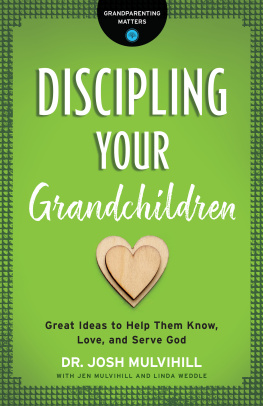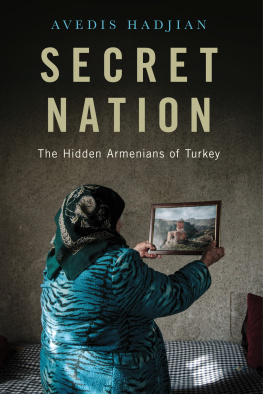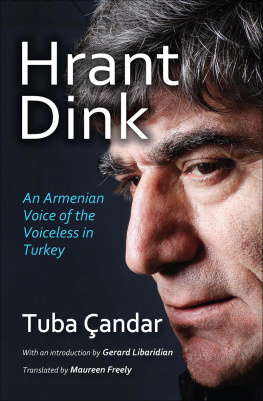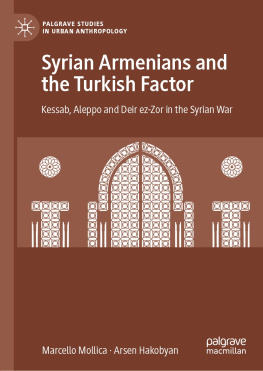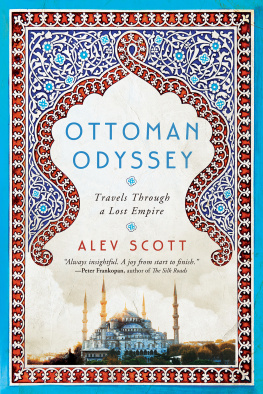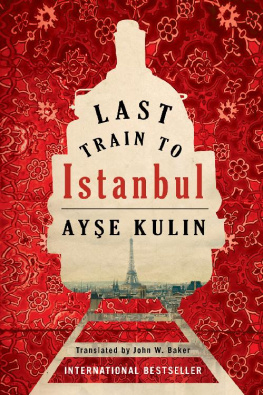The Grandchildren
Armenian Studies
Series Editor, Gerard J. Libaridian
Seta B. Dadoyan
The Armenians in the Medieval Armenian World. Paradigms of Interaction
Volume One: The Arab Period in Arminyah, Seventh to Ninth Centuries
Seta B. Dadoyan
The Armenians in the Medieval Armenian World. Paradigms of Interaction
Volume Two: Armenian Realpolitik in the Islamic World, Eleventh to Fourteenth Centuries
Seta B. Dadoyan
The Armenians in the Medieval Armenian World. Paradigms of Interaction
Volume Three: Medieval Cosmopolitanism and Images of Islam - Thirteenth to Fourteenth Centuries
Fuat Dndar
Crime of Numbers. The Role of Statistics in the Armenian Question (1878-1918)
Dikran Mesrob Kaligian
Armenian Organization and Ideology under Ottoman Rule: 1908-1914
Lisa Khachaturian
Cultivating Nationhood in Imperial Russia. The Periodical Press and the Formation of a Modern Armenian Identity
Transaction has been publishing works in Armenian Studies for many decades. The list of titles listed above include only those that have been released under the general editorship specified above, since 2008. Other Armenian Studies titles include works by Yair Auron, Vahakn Dadrian, Richard Hovannisian, Gerard Libaridian and others.
The Grandchildren
The Hidden Legacy of Lost Armenians in Turkey
Aye Gl Altnay Fethiye etin
With an introduction by Gerard Libaridian
Translated by Maureen Freely
First published 2014 by Transaction Publishers
Published 2017 by Routledge
2 Park Square, Milton Park, Abingdon, Oxon OX14 4RN
711 Third Avenue, New York, NY 10017, USA
Routledge is an imprint of the Taylor & Francis Group, an informa business
Copyright 2014 by Taylor & Francis.
All rights reserved. No part of this book may be reprinted or reproduced or utilised in any form or by any electronic, mechanical, or other means, now known or hereafter invented, including photocopying and recording, or in any information storage or retrieval system, without permission in writing from the publishers.
Notice:
Product or corporate names may be trademarks or registered trademarks, and are used only for identification and explanation without intent to infringe.
Library of Congress Catalog Number: 2013042796
This edition is an authorized translation from the Turkish language edition published by Metis Publishing Ltd. pek Sokak No.5, 34433 Beyolu, stanbul, Turkey. All rights reserved.
Library of Congress Cataloging-in-Publication Data
Torunlar. English
The grandchildren : the hidden legacy of lost Armenians in Turkey / edited by Ayse Gul Altinay and Fethiye Cetin ; translated by Maureen Freely.
pages cm. (Transaction Armenian studies special series)
Originally published in Turkish as: Torunlar / Ayse Gul Altinay, Fethiye Cetin. Beyoglu, Istanbul : Metis, 2009.
Includes bibliographical references.
ISBN 978-1-4128-5391-0 (cloth : acid-free paper) 1. ArmeniansTurkeyInterviews. 2. Armenian massacres survivorsTurkey. 3. TurkeyEthnic relations. 4. Collective memoryTurkey. I. Altinay, Ayse Gul, 1971-II. Cetin, Fethiye. III. Freely, Maureen, 1952-, translator. IV. Title.
DR435.A7A65513 2014
956.100491992dc23
2013042796
ISBN 13: 978-1-4128-5391-0 (hbk)
To Hrant Dink in loving memoryThis publication was made possible by a generous grant from the Dolores Zohrab Liebmann Fund
Contents
Aye Gl Altnay and Fethiye etin
Aye Gl Altnay and Fethiye etin
Fethiye etin
Gerard Libaridian
Bar
Deniz
Arif
Rya
Glin
Nkhet
Naz
Qesra Kiso Ozlemi
Mehmet
Bedrettin Aykn
Zerdt
Aya
Glad
Vecibe
Halide
Murat
Henaramn
ima
Salih
Melek
Asl
Ali
Berke Ba
Elif
Aye Gl Altnay
Maureen Freely
Aye Gl Altnay and Fethiye etin
This is not an easy book to read. The stories that follow were painful to tell, painful to hear, and painful to set down on paper. Only a few of the grandchildren we met were willing to share their stories in this volume. For those who agreed to do so, it was anything but easy, at least emotionally. And one had a change of heart very close to the time of publication. When this person informed us of her decision, we could hear deep fear and anxiety in her voice. Despite the fact that her story would remain anonymous, thus keeping her identity safe; this grandchild had been too deeply marked by the conflicts she had witnessed in the first decades of her life, not to mention the forced migration of her family from their Kurdish hometown in the 1990s, and the struggle to make a new life elsewhere, for her fears and anxieties to abate. The suffering of her Armenian grandfather was not in the past; three generations later, it was still shaping her present and her future.
This is not a book about 1915 so much as a book about what Hrant Dink described as being stuck in a well 1915 meters deep. It is a book that traces the deep scars that people living in these lands today still carry from the humanitarian catastrophe of 1915and that finds them in the most unexpected places.
Almost a century later, what does it mean to be a grandchild of those who survived 1915? At least as important is to ask what happened next: what have these survivors had to endure, these grandchildren, parents and grandparents, their neighbors, and their friends? A hundred years on, why is it still so difficult, so painful, for grandmothers and grandfathers (or mothers and fathers, or any of us) to own up to our Armenian heritage? If we found a way to face up to this pain, and to this silence, would this free us to identify other silences, other sources of anguish, bringing them to the surface by putting them into words? And could this process help to assuage yet other pains and silences before they have a chance to fester?
The narrators of these stories invite us to speak among ourselves, and with our families, our friends, and our neighbors, to listen to each others stories.
First, they told us their stories, face to face. Some of these meetings were over in an hour; others went on for much longer. After telling us how they came to find out that their grandmothers or grandfathers were Armenian, they described how they shared this information and with whom, and what effect it had on them at various points in their lives. Together we discussed what we knew about 1915 and the Armenian presence in our lands, and what we thought about the public debates of recent years, identifying together the breaking points and meeting points, the times of hope and despair, and our dreams for the present and the future. Some of these grandchildren found their own way to us; others we approached ourselves. Most were not people we had known beforehand. It was while talking to them that we discovered how much we had yet to learn even from those we thought we knew.




